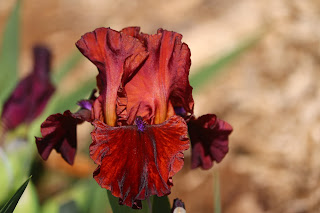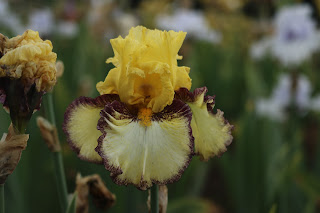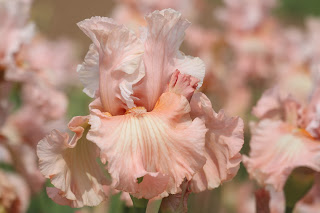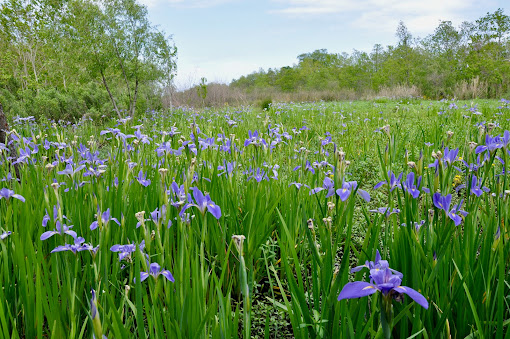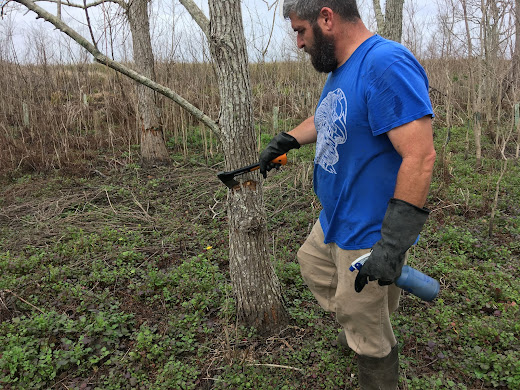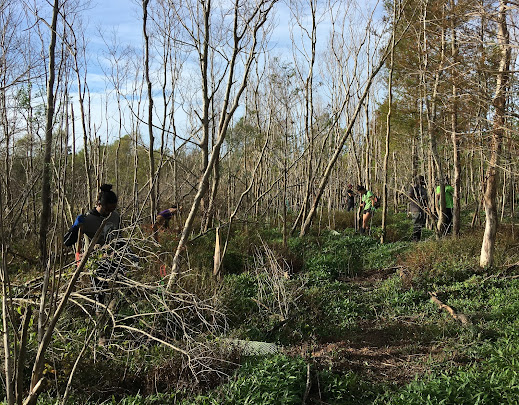By Tom Waters
Before 1958, the now familiar American Iris Society (AIS) horticultural classes for bearded irises did not exist. Certainly there were bearded irises of different sizes, but the precisely defined “dwarf,” “median,” and “tall” bearded classes were still gradually taking shape as a way to describing the diversity of the bearded irises in nature and in the garden. Today, we use “median” to refer to all the bearded irises except miniature dwarfs and tall bearded.
Consequently, care must be taken in assessing how the earlier bearded irises were categorized. This post will look at just one such category, the dwarf bearded irises, abbreviated DB prior to 1958.
 |
| DB 'Artoviolacea' (Todaro, 1856) probably a natural hybrid of I. lutescens and I. pumila Photo: El Hutchison |
In the early 1900s, botanists were aware of a number of dwarf bearded species, notably Iris pumila, I. lutescens (then mostly known by the name I. chamaeiris), I. aphylla, I. reichenbachii, and others. Gardeners in western Europe and the United States were also familiar with garden cultivars of dwarf bearded irises. These were almost exclusively forms of I. lutescens or hybrids between I. lutescens and other dwarf species. I. lutescens is native to the Mediterranean regions of France, Italy, and Spain. Other dwarf Iris species are native to Eastern Europe, and thus I. lutescens was more accessible to early commercial nurseries in France, England, Germany, and the Netherlands.
There was little concern about establishing a precise definition for the DB category. Dwarf cultivars being grown were easy to distinguish from tall beardeds (TBs), and that was really all that mattered. Crossing dwarfs with talls produced intermediates, another widely used term. The intermediate beardeds (IBs) were a pretty obvious group of hybrids and easily distinguished from both dwarfs and talls. Keep in mind that this was long before separate awards were established for different irises. Terms like dwarf, intermediate, and tall were helpful descriptions for irises rather than a specific horticultural class that needed to be assigned unambiguously.
 |
| DB 'Bride' (Caparne, 1901) probably pure I. lutescens, 6 to 8 inches in the author's garden photo: Tom Waters |
What were these early dwarfs like? Like the species I. lutescens that dominated their ancestry, the early dwarfs were mostly between 6 and 12 inches in height, almost never branched, bearing one or two terminal buds. Colors ranged from yellow, cream, and white, to blue, violet, and purple. Most had self or bitone color patterns. The spot pattern from I. pumila, so familiar to us in modern dwarfs, was seen only occasionally. All blooms were tailored, and the plants bloomed before the intermediates and talls. Although I. lutescens in the wild often shows interesting markings, patterns, and blended colors, these were not common among garden varieties. Perhaps this reflects the preference for clear, smooth colors that persisted among iris fanciers until the later decades of the 20th century.
 |
| DB 'Path of Gold' (Hodson, 1941), a child of 'Bride' and probably pure I. lutescens, is 10-12 inches in the author's garden. Photo: TomWaters |
As hybridizing progressed, it became clear that complicated hybrids might not always fall into one of the intuitive categories being employed. In 1948, the AIS adopted a new set of classes defined by L. F. Randolph. Randolph rejected height as a decisive factor, and offered instead a rather vague notion that advanced generation hybrids that had "most of the characteristics of typical dwarf bearded irises" (he had in mind things like season of bloom, short foliage and stalk, lack of branching, etc.) would be considered DBs.
This way of thinking about the class was soon pushed to the breaking point. Hybridizers had begun importing and working with different species, outside the familiar I. lutescens and its hybrids. Robert Schreiner had imported seeds of the tiny cold-hardy species I. pumila from eastern Europe, and this exciting new species gradually spread among dwarf hybridizers. Paul Cook introduced the first hybrids between I. pumila and TBs in 1951: 'Baria', 'Fairy Flax', and 'Green Spot'. Although the term had not yet been invented, these were the prototype of what would become the modern classification of standard dwarfs. Did these new irises have "most of the characteristics" of dwarfs? At a mere 10 inches, they were less than 18 inches tall, to be sure, but did having a TB parent make them intermediates? They were sometimes branched, not a characteristic of "typical" DBs of the time.
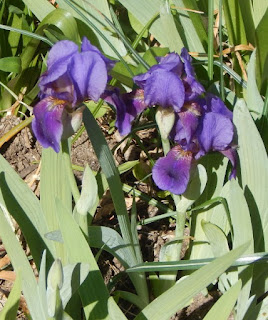 |
| DB 'Sapphire Night' (Nicholls, 1935), perhaps a hybrid involving I. lutescens and I. aphylla, 12-14 inches in the author's garden. Photo: Tom Waters |
Eventually the matter was settled by splitting the DB class in two: a miniature dwarf bearded (MDB) class with an upper height limit of 10 inches (reduced to 8 inches in 1976), and a standard dwarf bearded (SDB) class from 10 to 15 inches. The MDBs were the province of the Dwarf Iris Society, whereas the SDBs were regarded as medians and promoted by the Median Iris Society.
The effects of Cook's new hybrids were not limited to the classification system. Excited by the developments, dwarf hybridizers scrambled to use I. pumila and the new SDBs in their breeding. The 1950s was a transition decade: it began with nearly all DBs being cultivars or hybrids of I. lutescens, and ended with nearly all MDBs and SDBs being hybrids of I. pumila and TBs in varied proportions. The influx of TB genes brought plicatas, pinks, and ruffled blooms into the dwarf iris world; I. pumila brought dramatic and varied spot patterns.
What does this all mean for the collector of historic dwarf bearded irises? First, it is essential to understand that the DB class does not correspond to any single modern class. It spans the height range of both MDB and SDB classes, even extending into the IB class in some instances. In principle, every historic DB could be assigned to a modern class on the basis of height. However, height was not recorded in early registration data; so such determinations would require catalog descriptions or garden observations. The Median Iris Society attempted to make such reassignments for the IB, MTB, and BB classes, although I do not know of any similar undertaking having been made for the MDBs and SDBs.
Even if we were able to sort historic DBs into modern classes based on height, that would not capture the essential nature of the old category. It represents irises of different ancestry and genetic characteristics than the modern classes. The 8-inch height boundary is even less meaningful for the old DBs than it is for their modern successors. I. lutescens and its hybrids span this boundary, and there is seldom any meaningful difference between a 7-inch and a 10-inch DB.
I think the best advice for modern growers interested in collecting historic dwarfs is to approach them on their own terms: viewing the DB category in its own right with context that differs from modern hybrids. Starting from that perspective, one can then notice some similarities and comparisons that might be made: A DB that is a I. lutescens/pumila hybrid, for example, might resemble an MDB that is an SDB/I. pumila hybrid.
The historic DBs are harder to come by than modern cuiltivars, but it is worthwhile to acquire and grow a few. Not only will you be helping to preserve a window into iris history, you will also get to enjoy a type of iris that really has no modern counterpart.










